
Somersworth is a city in Strafford County, New Hampshire, United States. The population was 11,855 at the 2020 census. Somersworth has the smallest area and third-lowest population of New Hampshire's 13 cities.

West Warwick is a town in Kent County, Rhode Island, United States. The population was 31,012 at the 2020 census.
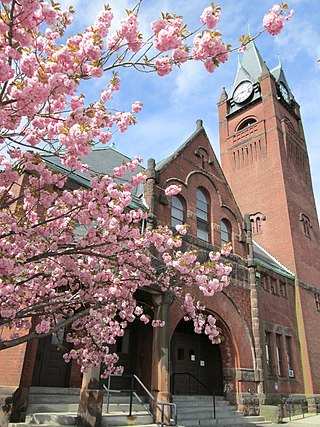
Ware is a town in Hampshire County, Massachusetts, United States. The population was 10,066 as of 2020. It is part of the Springfield, Massachusetts Metropolitan Statistical Area.

South Attleboro is a village of Attleboro, a city in Bristol County, Massachusetts, United States. It was formerly known as SouthGate, and has its own telephone exchange separate from Attleboro. It is perhaps best known for the South Attleboro station on the Providence/Stoughton Line of the MBTA Commuter Rail. U.S. 1 and Route 1A pass through the area, which lies just north of the Rhode Island state line.

The Amoskeag Manufacturing Company was a textile manufacturer which founded Manchester, New Hampshire, United States. From modest beginnings it grew throughout the 19th century into the largest cotton textile plant in the world. At its peak, Amoskeag had 17,000 employees and around 30 buildings.
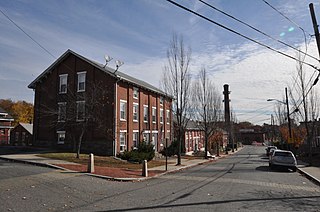
Lonsdale is a village and historic district in Lincoln and Cumberland, Providence County, Rhode Island, United States, near Rhode Island Route 146 and Route 95. The village was originally part of the town of Smithfield until Lincoln was created in the 1870s, and was originally centered on the Lincoln side of the Blackstone River. William Blaxton settled in the area in 1635. In the nineteenth and early twentieth centuries, Lonsdale was home to several manufacturers including the Lonsdale Company's Bleachery, and the Ann & Hope mill was also located in the village in Cumberland.

The Ashton Historic District is a historic district in Cumberland, Rhode Island. The district consists of a mill and an adjacent mill village that was built for the workers of the mill. It lies between Mendon Road, Scott Road, Angell Road, Store Hill Road, Front Street and Middle Street. The district was added to the National Register of Historic Places on November 1, 1984.
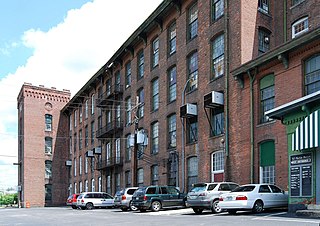
Berkeley Mill Village is a historic district encompassing the mill village of Berkeley in Cumberland, Rhode Island. The village is roughly bounded by Martin Street and Mendon Road on the north and east, railroad tracks to the west, and St. Joseph Cemetery to the south. The village, including a mill complex and mill employee housing, was built in 1872 by the Lonsdale Company. Most of the residential structures built are two-story brick duplexes, although Mendon Street is lined with a number of fine Queen Anne Victorian houses. A c. 1892 Stick-style church building, stands on Mendon Street at the northern end of the district.
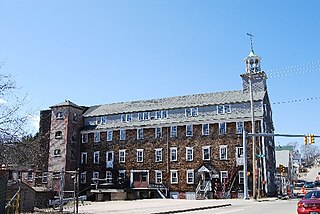
The Lippitt Mill is a historic mill at 825 Main Street in West Warwick, Rhode Island.

Pontiac Mills is a historic textile mill complex on Knight Street in the village of Pontiac, Rhode Island within the city of Warwick. The mills produced the original Fruit of the Loom brand of cloth.
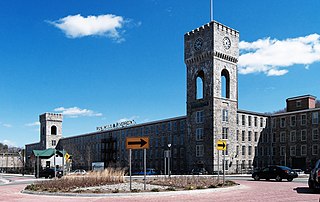
The Royal Mill Complex is an historic textile mill site at 125 Providence Street in West Warwick, Rhode Island. The mill complex was listed on the National Register of Historic Places in 2004. It has recently been completely renovated and remodeled into 250 residential apartments. The complex also includes the Ace Dye Works mill on the south side of the river, which has been converted into lofts. A pedestrian skybridge connects the two mills.

The Valley Queen Mill is an historic mill at 200 Providence Street in West Warwick, Rhode Island.

Colonel Richard Borden (1795–1874) was an American businessman and civic leader from Fall River, Massachusetts. He co-founded the Fall River Iron Works in 1821, and later built several early cotton mills, as well as the Fall River Line, Fall River Gas Works Company, the Fall River Railroad, banks and other businesses. The Borden family would dominate the economic and civic life of Fall River into the early 20th century.

Robert Knight was a New England industrialist and philanthropist, who was a partner with his brother Benjamin Knight in B. B. & R. Knight and was one of the largest textile manufacturers in the world when he died in 1912. He co-founded the clothing brand Fruit of the Loom, now owned by Warren Buffett's Berkshire Hathaway.

Benjamin Brayton Knight (1813–1898) was a New England industrialist and philanthropist, who was a partner with his brother Robert Knight in the B. B. & R. Knight Company and was one of the largest textile manufacturers in the world when he died in 1898. Knight co-founded the large and famous brand, Fruit of the Loom.

Ainsworth Mill, Breightmet is a mercerising mill near the Breightmet neighborhood of Bolton, Greater Manchester. It was bought by the Lancashire Cotton Corporation in the 1940s as an attempt to develop a cotton finishing presence.

The 1926 Passaic textile strike was a work stoppage by over 15,000 woolen mill workers in and around Passaic, New Jersey, over wage issues in several factories in the vicinity. Conducted in its initial phase by a "United Front Committee" organized by the Trade Union Educational League of the Workers (Communist) Party, the strike began on January 25, 1926, and officially ended only on March 1, 1927, when the final mill being picketed signed a contract with the striking workers. It was the first Communist-led work stoppage in the United States. The event was memorialized by a seven reel silent movie intended to generate sympathy and funds for the striking workers.

Lippitt, Rhode Island is a village within the town of West Warwick, Rhode Island.

Arkwright is a village in the northeastern corner of Coventry, Rhode Island touching Cranston and Scituate, now connected by Route 115.

The New England Textile Strike was a strike led by members of the United Textile Workers of America (UTW) principally in the U.S. states of Massachusetts, New Hampshire, and Rhode Island. Throughout the duration of the strike, an estimated 68,000–85,000 workers refused to work. Alongside the UTW, the IWW and ATW played major organizing roles within it, with the strike lasting for around 200 days at most mills.
























